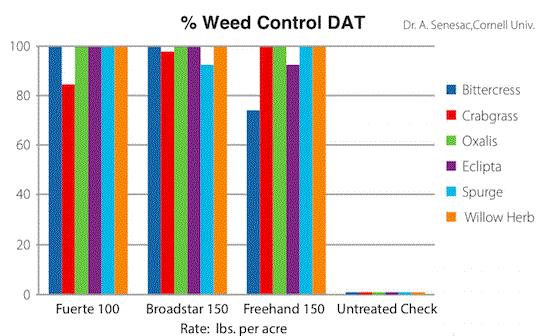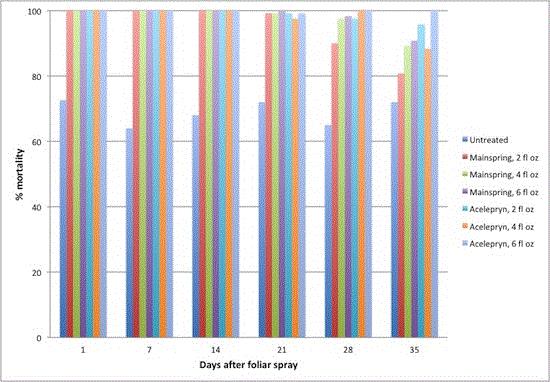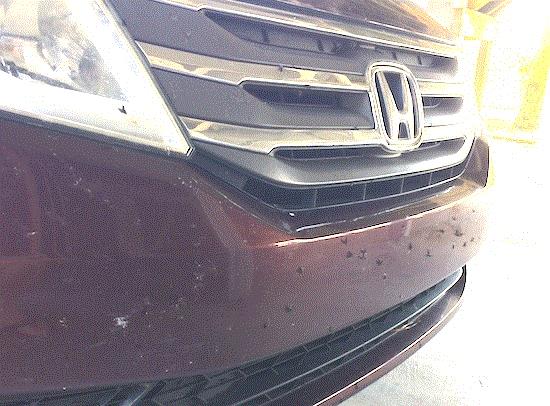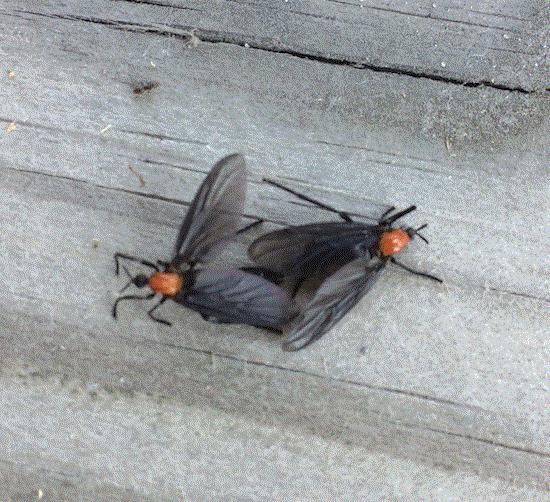OHP introduces Fuerte herbicide
Fuerte herbicide is the newest addition to OHP’s portfolio, with registration approved in all states except California and Arizona (and Puerto Rico) as of August 1. Fuerte is a dustless granular pre-emergent herbicide, containing 0.125% flumioxazin and 0.75% prodiamine. Y’all are familiar with flumioxazin and prodiamine, right? These two preemergent herbicides have been around for some years. Flumioxazin is a Group 14 herbicide, and a granular formulation is available to the green industry in a single compound as BroadStar, or in combination with other herbicides as SurePower and Tetra. Prodiamine (Group 3) is better known as Barricade (and many other generics), and available in granular formulation in a single compound as RegalKade, and in combination with other herbicides as Biathlon, Gemini, RegalStar II and others. Fuerte is the first product that combines flumioxazin and prodiamine.
Fuerte is registered for preemergent control of grassy and broadleaf weeds in field and container nurseries, landscapes, Christmas tree farms and conifer farms. Fuerte is not registered for use on vegetables or edible fruit-bearing crops, bedding plants or flowering plants. Fuerte is safe for many trees and woody shrubs; consult the label for a complete list of tolerant plants, precautions for certain species, and limitations for use in California. Fuerte is known to injure some shrubs, such as butterfly bush, clethra and hydrangea. Fuerte’s Product Information Sheet provides a list of non-tolerant plants.

Fuerte should not be applied to wet plants because granules stick to wet foliage and can cause phytotoxicity even on tolerant plant species. For liners with root balls less than four inches in diameter, do not apply Fuerte within six weeks of transplant or before the liners have established vigorous root systems. For container grown ornamentals, do not apply Fuerte to newly transplanted liners until the potting medium has settled. For landscape ornamentals, apply Fuerte one week after transplant, and irrigate with a half inch of water after application and do not disturb soil.
Fuerte is available in 50-lb. bags. The application rate is 100 pounds per acre. Two applications, three months apart, can be made in a year. The required Personal Protective Equipment (PPE) includes long pants, a long-sleeved shirt, waterproof gloves, shoes and socks. The restricted entry interval (REI) is 12 hours.
I’m sure y’all are curious about the efficacy of Fuerte.
In Fuerte’s Product Information Sheet, OHP presents data from a study conducted by Andy Senesac of Cornell University comparing the efficacy of Fuerte applied at 100 lb. per acre, Broadstar applied at 150 lb. per acre and Freehand (dimethenamid-P + pendimethalin) applied at 150 lb. per acre against five broadleaf and one grassy weed species. Fuerte was shown to completely inhibit germination of bittercress, oxalis, eclipta, spurge and willow herb, which was slightly better than Broadstar in terms of spurge prevention, and Freehand in terms of bittercress and eclipta prevention. Fuerte inhibited germination of over 80% of crabgrass, which was a slightly lower level of weed control than those achieved by Freehand and Broadstar. For most of the common weeds, Fuerte will be a good rotation partner with other preemergent herbicides y’all are already using.

Graph courtesy of OHP.

Acelepryn now registered for greenhouse and nursery
Acelepryn has been around since 2008, when DuPont first introduced it to the turf market. Syngenta acquired the product in 2012, and maintained the original turf and landscape registrations. Syngenta announced on August 15 that the EPA has approved the registration of Acelepryn for uses in nurseries and greenhouses.
Acelepryn contains chlorantraniliprole, a Group 28 systemic insecticide. Acelepryn was introduced many years before its cousins, Mainspring (cyantraniliprole) and Sarisa (cyclaniliprole). The new label includes foliar sprays against leaf-feeding caterpillars, soil applications (via injection, drench or spray) and container drench applications against white grubs, aphids and lace bugs, and trunk spray applications against clearwing borers. Acelepryn has no signal word, and its restricted entry interval is four hours. Click here for more information about Acelepryn.

The strengths of Acelepryn are its safety for pollinators and beneficial insects, and its strong efficacy against beetles and caterpillars. Syngenta provides summaries of several studies on the Acelepryn website. One study was conducted by Stanton Gill of the University of Maryland, showing that Acelepryn sprayed at 8 fl. oz. per 100 gal. prevented foliage damage by adult Japanese beetles on stewartia better than beetleGONE! (Bacillus thuringiensis galleriae). Steve Frank of North Carolina State University showed that Acelepryn applied at 0.125 and 0.25 fl. oz. per foot shrub height provided reductions in crape myrtle aphid populations comparable to that of Marathon applied at 0.66 oz. per foot height.
I ran two studies to determine the efficacy of Acelepryn and Mainspring against caterpillars.
The first study was conducted in 2018 to evaluate the efficacy and residual longevity of Acelepryn and Mainspring against beet armyworm on chrysanthemum. Acelepryn and Mainspring were applied to mum plants as foliar sprays at rates of 2, 4 and 6 fl. oz. per 100 gal., and as a medium drench at 6 and 8 fl. oz. per 100 gal. (Each six-inch pot was drenched with 4 fl. oz. of solution.) The treatments were made only once. Treated leaves were collected the day of the treatment, and at 7, 14, 21, 28 and 35 days after the spray treatment, or 14, 21, 28, 35, 42 and 49 days after the drench treatment. Beet armyworm hatchlings were then introduced to the detached leaves, and their mortality observed after four days of exposure. The goal of this experiment was to determine if preventive treatments of Acelepryn and Mainspring could reduce successful invasion by the beet armyworm. I chose to infest the plants with hatchlings because beet armyworm infestations often start with adult moths attracted to the greenhouse and hatchlings result from the eggs deposited by these adults.
I’m presenting data from only the foliar treatment in the following graph because the current Acelepryn label only lists foliar sprays for caterpillars. Beet armyworm hatchlings are quite fragile, so there were high levels of mortality even on the untreated leaves. My study showed that foliar sprays of Mainspring and Acelepryn achieved greater than 90% mortality up to 28 days after treatment and more than 80% up to 35 days after treatment. Acelepryn sprayed at 6 fl. oz. per 100 gal. maintained 100% mortality up to 35 days after treatment. Acelepryn and Mainspring seemed to be equally effective, and lower application rates seemed to perform as well as the higher rates. Drench treatments performed as well as foliar sprays, and with residual efficacy extended by two weeks longer than foliar sprays.

The second study was conducted against European pepper moth infesting coral bells, and it was completed just last week. This study evaluated the efficacy of Mainspring and Acelepryn applied as a sprench at 4 and 8 fl. oz. per 100 gal. The coral bells in this grower’s greenhouse were infested with adult moths that were free to move about in the greenhouse. Only one application was done at the time when adult moths were first observed. The plants were observed for live caterpillars at the base of the plants or in the potting medium, feeding damage on the foliage, and dead plants for 49 days after treatment.
Mainspring and Acelepryn at both rates did an excellent job in preventing attacks by the European pepper moths. Live caterpillars were found only on untreated plants. On average, 57% of the untreated plants suffered foliage damage, and 13% of the untreated plants died from the infestation or from diseases invading through the feeding wounds. Only 3% of plants treated with 4 fl. oz. of Acelepryn and Mainspring suffered some level of foliage damage, but none of the plants treated at the higher rates suffered any damage even at 49 days after treatment. No plants treated with Mainspring or Acelepryn died during the experiment.
My studies tell me that Acelepryn is very effective as a curative or preventive tool against caterpillars. You can expect excellent (greater than 90% control) residual efficacy for at least four weeks with one foliar spray of Acelepryn, with the residual efficacy period being even longer at the higher application rate. The product not only kills the caterpillars, it can also protect the foliage from feeding damage.

Darn! Love is in the air!
I’m not the romantic kind, much to the chagrin of my lovely wife.
We were in Edisto Beach this weekend for a romantic getaway. (Read, “A post-Hurricane Dorian cleanup,” in JC’s brain.) Three things became quite clear as soon as we arrived: First, Edisto Beach is lucky, suffering very little visible damage. Second, all mosquitoes on the island have volunteered en masse for biting patrol. And lastly, the lovebugs are busy being suicidal. Or they’re blinded by their desires and forget to avoid incoming car windshields, hoods, radiator grills and bumpers.

Those of us living along the Gulf Coast, and the Georgia and South Carolina coasts are familiar with lovebugs. We also know that, once they’re smeared on your windshields and bumpers, no amount of wiping and scrubbing can get them off. They’re no mere marsh flies—they’re annoyance personified!
We didn't see a huge number of lovebugs along the South Carolina coast until the 1990s, but they have been known to be around the Gulf Coast since the 1910s. No one knows for sure where the lovebugs came from. One thing is for sure—they are not the results of a genetic experiment at the University of Florida gone terribly wrong! We blame Florida for a lot of things, but lovebugs ain’t one of them.

Just like gnats that love to fly into your eyes, I don't know what to tell you other than “just bear with it.” They are in huge numbers during a short time in the spring (usually around May) and summer (usually August into September). Exclaiming “Oh, they love each other. So cute!” whenever the death toll on the windshield reaches 500 may help alleviate some burning rage. Larvae feed on detritus, but it’s simply not feasible to treat all the debris in the environment to get rid of the lovebugs.
Also, remember to keep your mouth shut while enjoying a ride.






See y'all next time!

JC Chong
Professor of Entomology at Clemson University
This e-mail received by 25,257 subscribers like you!
If you're interested in advertising on PestTalks contact Kim Brown ASAP!